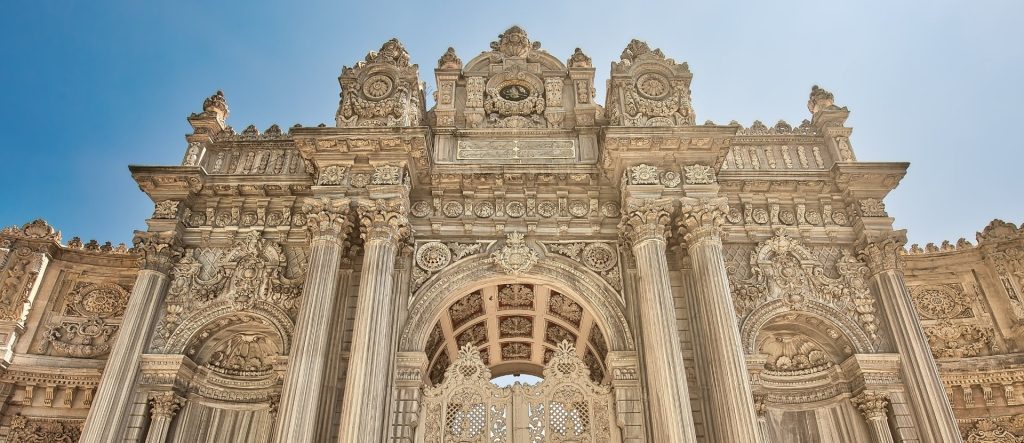Explore Dolmabahçe Palace
Below, you will find four grand halls of splendor. Each opens a door to a different facet of the palace’s soul.
Choose your journey: Will you marvel at the harmony of its grand design, witness the dazzling power of its ceremonial life, step into the elegant world of the imperial family, or behold the priceless masterpieces in its collections?
Your path into the heart of 19th-century imperial grandeur begins with a single choice.
Explore The Four Grand Halls of Splendor
Design & Architecture
Step into a masterpiece of synthesis, where European grandeur and Ottoman artistry unite. Explore the architectural vision that defines the palace’s magnificent, harmonious whole.
The Imperial Family Quarters
Unveil the elegant and private world of the modern Ottoman dynasty. Discover the luxurious daily life, traditions, and secrets of the last sultans in their Bosphorus residence.

The Ceremonial Splendor
Witness the breathtaking power of the empire’s final act. Ascend the Crystal Staircase and stand in the awe-inspiring halls where imperial ceremony and global diplomacy unfolded.
The Palace Collections
Behold a treasure trove of priceless masterpieces. From the grand paintings of the Painting Museum to the world’s finest Hereke carpets, immerse yourself in the art that defined an era.
Where the Palace Meets the Palate
Lacivert: The Bosphorus, Reimagined for Your Palate
You’ve witnessed the imperial grandeur from within the palace walls.
Now, experience its reflection across the water. At Lacivert, the timeless silhouette of Istanbul meets the vibrant flavors of the Mediterranean, creating a memory worthy of the view.
A Note from Our Curators
To truly explore Dolmabahçe Palace is to understand that it is not a chronicle of history, but a deliberate masterpiece of art. The experience presented here is curated not just to show, but to dazzle.
We invite you to look beyond the opulence and see the bold vision embedded in every crystal, every gilded detail, and every brushstroke—the final, magnificent statement of an empire.
A Recommemded Reading

The Testament of an Era
Professor İlber Ortaylı's masterwork, "The Empire's Longest Century," is not merely a history book; it is the essential key that unlocks the meaning behind every crystal chandelier and gilded hall. It is the story of the will that built this palace.

The Unsealed Blueprint
Dolmabahçe was not built of marble; it was built of ambition. Every gilded detail and crystal fixture was a carefully chosen word in the Ottoman Empire’s final, magnificent message to the West.
This investigation deciphers that proclamation, revealing how stone and light were forged into a language of power, modernity, and defiance.

More Than Marble: Why Dolmabahçe’s Architecture Was a Message
Enrich Your Exploration

Medicana: A Legacy of Health

Avis: The Keys to the City
FAQ: Frequently Asked Questions about Dolmabahçe Palace
What is the main difference between the Selamlık and Harem sections?
The Selamlık was the official, public part of the palace used for state affairs, ceremonies, and receiving foreign dignitaries—it was designed to impress and project imperial power. The Harem was the private, secluded quarters for the Sultan and the imperial family, focusing on daily life, family, and tradition.
I'm an art lover. Which part of the palace should I prioritize?
While the entire palace is a work of art, you must prioritize the National Palaces Painting Museum. Located in the former apartments of the heir-apparent, it houses a magnificent collection of 19th and early 20th-century Turkish and international art, offering a deep dive into the era’s aesthetic world.
What makes the architecture of Dolmabahçe so unique?
Dolmabahçe Palace represents a stunning synthesis of European architectural styles—including Baroque, Rococo, and Neoclassical—blended with traditional Ottoman design elements. It was a conscious statement of the empire’s modernization and its dialogue with the West, moving away from the pavilion-based layout of Topkapı to a grand, monolithic European-style palace.
Can I see all the famous crystal and gold decorations on a standard tour?
Yes. The most iconic features, such as the Crystal Staircase, the crystal chandeliers (including the world’s largest), and the lavish gold leaf decorations in the Ceremonial Hall (Muayede Salonu), are all part of the main Selamlık tour route.
How is the Harem at Dolmabahçe different from the Harem at Topkapı Palace?
The Harem at Dolmabahçe reflects a more modern, European-style royal family life. Unlike the labyrinthine, secluded Harem of Topkapı, the quarters here are more integrated, spacious, and furnished in a Western style, reflecting the changing role and structure of the imperial family in the 19th century.
Are the Palace Gardens part of the "Explore" experience?
Absolutely. The meticulously designed gardens are an integral part of the palace’s grand design. From the grand sea-facing gates to the tranquil Harem garden, they offer stunning views of the Bosphorus and a chance to appreciate the palace’s magnificent exterior architecture.
Is there a single "must-see" artifact in the Palace Collections?
While the painting collection is vast, the most famous single artwork is arguably Ivan Aivazovsky’s “Ceremony of Leaving for the Palace,” which depicts a historical scene right in front of the palace itself. Another highlight is the world’s finest collection of imperial Hereke carpets, masterpieces of Ottoman weaving.







